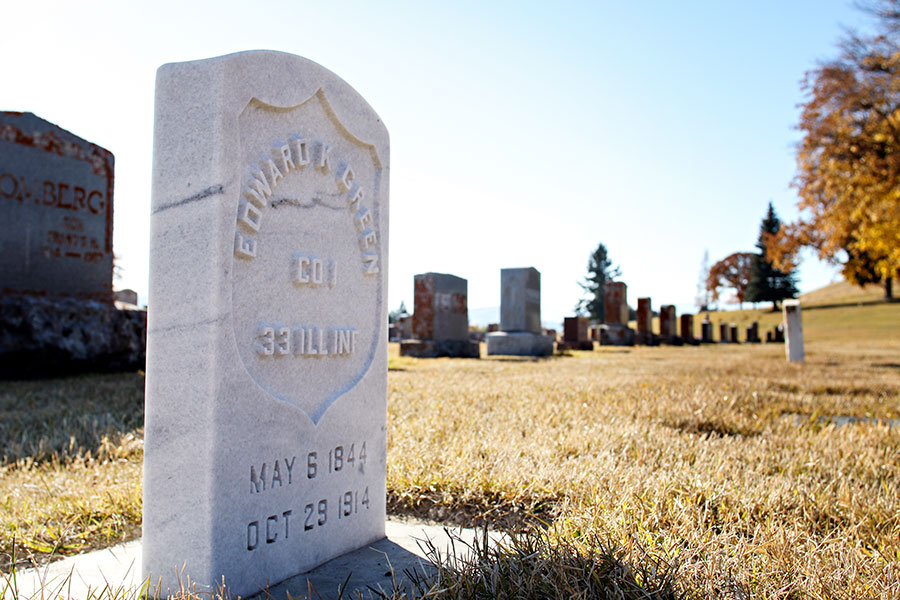After a Century, a Civil War Veteran Gets a Proper Tombstone
Great-granddaughter teams up with local veterans to secure military headstone for soldier buried in unmarked grave at Conrad Cemetery
By Myers Reece
For 104 years, a Civil War soldier’s grave sat unmarked in Kalispell’s C.E. Conrad Memorial Cemetery, a barren patch of grass obscuring a family legacy.
If not for the diligent document-finding of his great-granddaughter, and the efforts of local veterans, Edward K. Green of the Union Army’s 33rd Illinois Infantry Regiment may have laid at rest without a proper marker forever.
Earlier this year, Teresa Pascarelli reached out to the Glacier Park VFW Post 2252 to inquire about securing a military headstone for her great-grandfather. Pascarelli, who lives in Georgia and grew up hearing stories about her great-grandparents, had traveled to the Flathead with her husband three years ago to learn more about Green and his wife Celia, known around the valley at the time as “Ma” or “Mother” Green.
On Pascarelli’s trip, she stumbled upon a goldmine of family historical information in the local library’s newspaper archives, learning that her great-grandparents were prominent early figures in Whitefish. Edward was a contractor who built railroad beds and other roads, including in Glacier National Park. He and Celia had followed their son, Carl, an engineer with Great Northern Railway, to Whitefish in the early 1900s. The Greens built a number of buildings in town, including their two-story home downtown.
Today, the Greens’ home is Wasabi Sushi Bar and an upstairs flat. In the early 1900s, however, it was ground zero for the Greens’ entrepreneurism and community involvement, particularly Celia’s after Edward’s death in 1914. Celia, an influential businesswoman, was instrumental in bringing electricity and telephone connectivity to Whitefish, among other endeavors.
Celia lived downstairs in what is now the sushi restaurant and rented the upstairs to railroaders. According to a 1940 article in the Whitefish Pilot, Celia had an open-door policy and welcomed streams of visitors who were eager to chat with her. After she died, all businesses in town shut down during her funeral service.
Pascarelli was pleasantly surprised to discover a photo of Celia still hanging in the entryway of Wasabi, as well as a picture of her at the Stumptown Historical Society’s museum.
“I had seen the one in the museum when I was growing up,” Pascarelli said last week. “We grew up seeing photos and hearing stories.”
After visiting Green’s unmarked grave, Pascarelli learned that veterans, through an application and with appropriate paperwork, could receive a free headstone from the federal government. She was determined to get one for her great-grandfather.
Pascarelli reached out to the local VWF post, whose members put her in touch with Ryan Keeler at Kalispell’s Montana Veterans Affairs office, which processes applications for veteran grave markers.
Pascarelli secured Green’s military records through the National Archives, but there were small hiccups along the way. For one, Keeler said he was told by someone in Quantico, Virginia, home to the national cemetery and where military tombstones are approved and made, that they needed a Social Security number.
“They didn’t have Social Security numbers back then,” Keeler said.
Ultimately, the application satisfied requirements. Green’s granite headstone was shipped from Quantico to the Conrad cemetery, where it was set in place in late August.
“There was really good documentation for it being from way back then,” Keeler said.
Pascarelli said the VFW post and Keeler were supremely helpful in ushering her through the process, as was Jim Korn, the sexton at Conrad Memorial Cemetery.
“They were so wonderful to me,” she said. “Everyone was so phenomenal. Without everyone’s expertise and help, I don’t know that I would have gotten it through. I was thrilled.”
Carey Dill, a Marine Corps veteran who everyone knows as “Dill Pickle,” said his VFW post, which has 400 members in the Flathead Valley, is frequently involved with helping veterans’ families secure military grave markers, and Keeler said his office regularly receives inquiries. But they’re typically for recently deceased veterans, maybe a bit older, though never for Civil War veterans.
“This is the oldest one we’ve ever done,” Dill said. “It’s once in a lifetime for this to happen, to get a chance to do a Civil War veteran headstone.”
Pascarelli hasn’t had a chance to see the tombstone in person yet, but she hopes to visit the Flathead in the future.
“I’d love to go back someday,” she said. “That was really a special trip.”
Jerry Stewart, commander of the local VFW post, said a lot of people only associate the VFW with its bar, known as a “canteen,” but don’t know about its many community activities, including raising money for nonprofits, working with hunting and fishing organizations and donating to schools.
“We do an awful lot,” Stewart said.
This summer, the post was honored with the National Outstanding Community Service Award out of all VFW posts in the country.
“For a post in a town this size to get that national award is pretty awesome,” Keeler, who serves as the post’s sergeant in arms, said.
One particular point of pride for the post is helping veterans and their families get military grave markers, with the Green headstone standing out as a shining example.
“This is a good story to let the public to know that we don’t quit on our veterans and we get them what they’re deserved,” Dill said. “And there’s no time limit for a headstone. The proof is right here.”